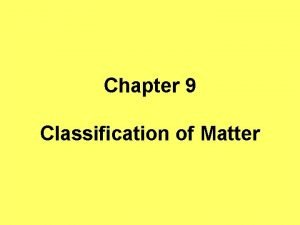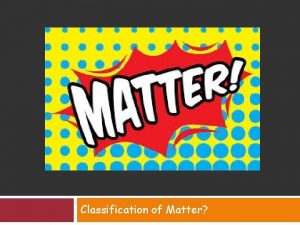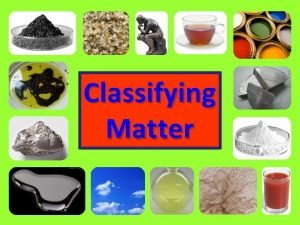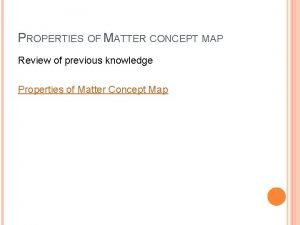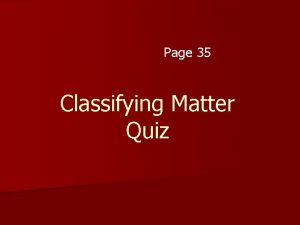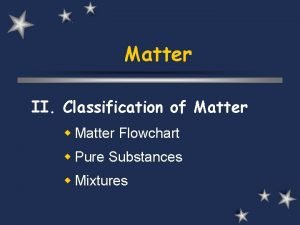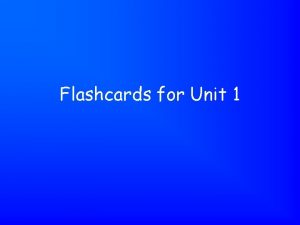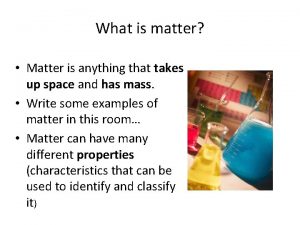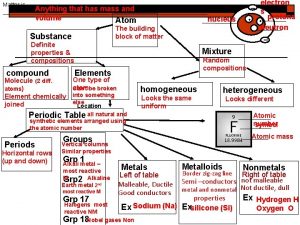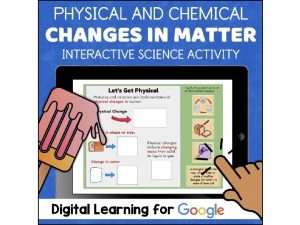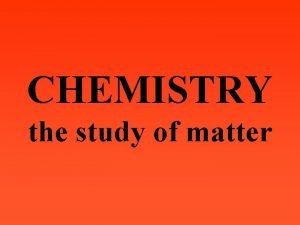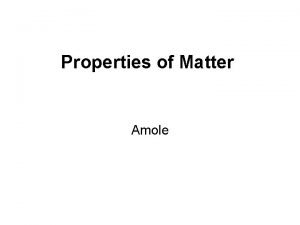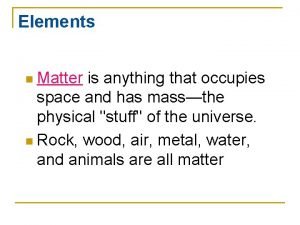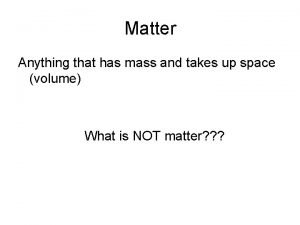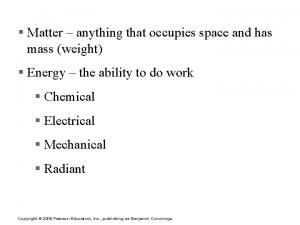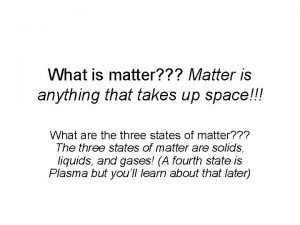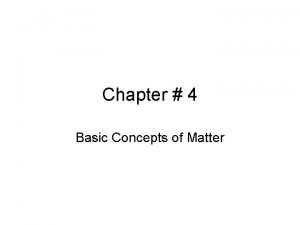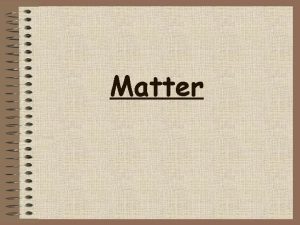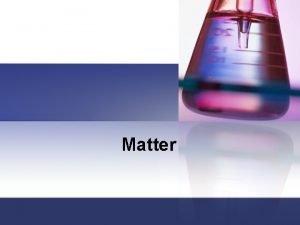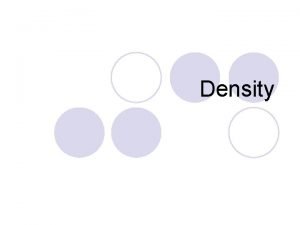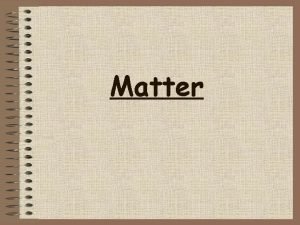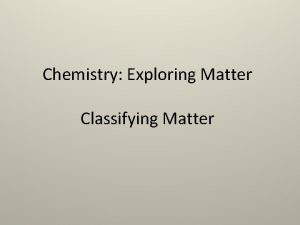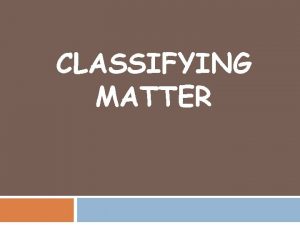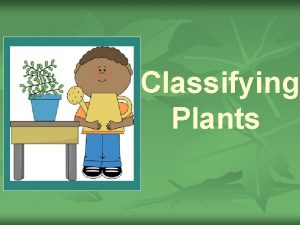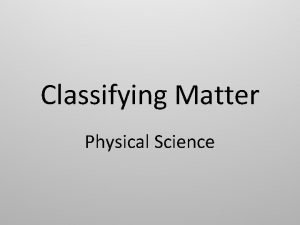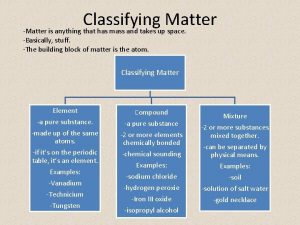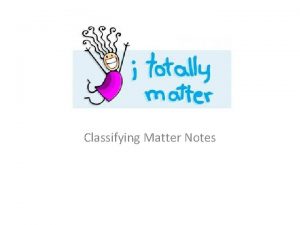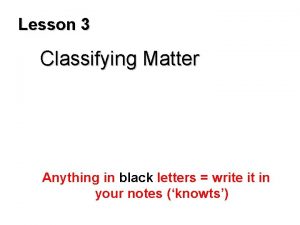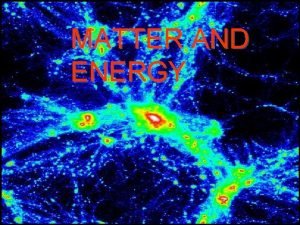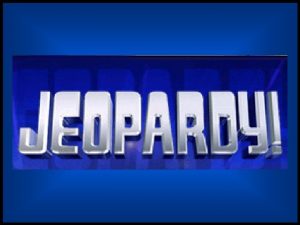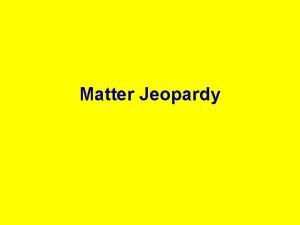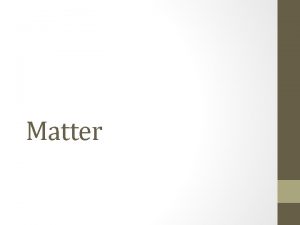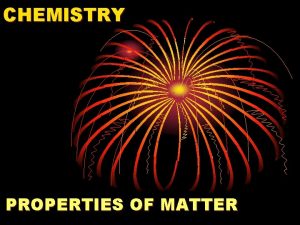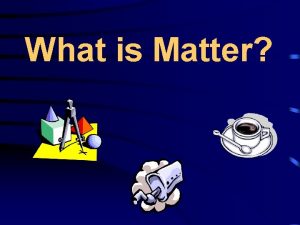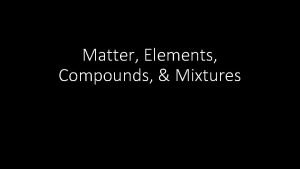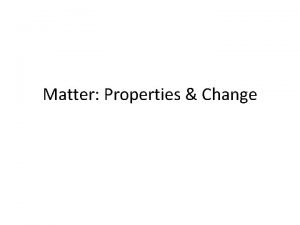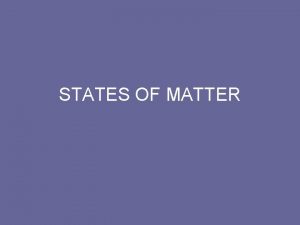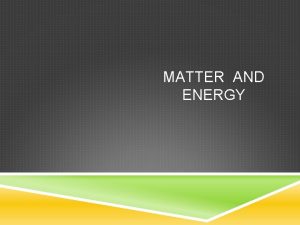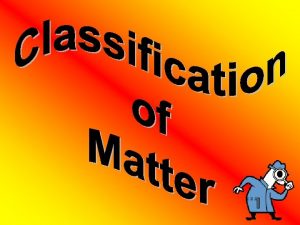Classifying Matter Understanding Matter Matter is anything that













































- Slides: 45

Classifying Matter

Understanding Matter • Matter is anything that has mass and takes up space. • Obviously, there are different types of matter. • Metal, wood, plastic, your flesh are all obvious pieces of matter.

Understanding Matter • Air is also matter. • Air molecules have mass and take up space. • Sound and light are not matter. • Forces and energy are not matter. • To be matter, something must have mass and take up space.

Atoms • An atom is a small particle that is a building block of matter.

Atoms • An atom is almost too small to even imagine. • Look at a piece of human hair. • The diameter, or distance across the hair on its smallest side is still 1, 000 times bigger than an atom.

Atoms • Atoms are made of three parts. • The center of the atom is called the nucleus. • Protons, positively charged particles, and neutrons, neutrally charged particles, make up the nucleus.

Atoms • Electrons, negatively charged particles, move quickly around the nucleus in an area called the electron cloud.


Atoms • Not all atoms have the same number of protons, neutrons, and electrons. • Having different numbers of protons cause these atoms to have different properties and act in different ways.

Substances • A substance is matter with a composition that is always the same. • This means that a given substance is always made up of the same combinations of atoms.

Substances • Any piece of aluminum is made of the same type of atoms. • Water is always made of hydrogen and oxygen atoms in a certain combination. • Anything else would not be water.

Substances • There are two types of substances – elements and compounds.

Elements • An element is a substance that consists of just one type of atom. • The periodic table of elements is a way we’ve organized the types of atoms we have discovered. • There are 118 different elements known because there are 118 different types of atoms known.


Elements • Each type of atom contains a different number of protons in its nucleus. • An aluminum atom has 13 protons in its nucleus. • Notice on the periodic table, aluminum (Al) has the number 13 above it. • 13 is its atomic number, or the number of protons in its nucleus.

Elements • The symbol for aluminum is Al. • A chemical symbol is either one capitalized letter or one capitalized letter with a lower case letter after it.

Elements • Most elements can exist as individual atoms. • For example, a roll of pure aluminum foil is made of trillions of individual aluminum atoms.

Elements • Some atoms, however, exist in groups. • Oxygen atoms in the air exist as pairs. • Oxygen atoms will not exist by themselves if even one other oxygen atom is nearby.

Elements • Whether the atoms of an element exist individually like aluminum or in groups like oxygen, an element contains only one type of atom. • It’s composition is always the same.

Compounds • A compound is a type of substance that contains atoms of two or more different elements chemically bonded together. (We’ll talk about chemical bonds later)

Compounds • Carbon dioxide (CO₂) is a compound. • It is made of carbon atoms and oxygen atoms. • These are different elements bonded together chemically. • Carbon dioxide is a substance because the C and the O atoms are always combined in the same way.

Compounds – Chemical Formulas • The combination of symbols and numbers that represent a compound is called a chemical formula. • Chemical formulas show the different atoms that make up a compound, using their element symbols.

Compounds – Chemical Formulas • Chemical formulas also help explain how the atoms combine. • CO₂ is the chemical formula for carbon dioxide. • The formula shows that carbon dioxide is made of carbon (C) and oxygen (O) atoms.

Compounds – Chemical Formulas • The small ₂ is called a subscript. • This means that in CO₂, there are two oxygen atoms. • The ₂ is attached to the O. • There is only one carbon atom because there is no subscript written after the symbol.

Compounds - Chemical Formulas • Practice: Identify what types of atoms and how many of each are in each compound. 1) H₂O (water)

Compounds - Chemical Formulas 2) HCl (Hydrochloric acid)

Compounds - Chemical Formulas 3) C 6 H 12 O 6 (Glucose sugar)

Compounds – Properties of Compounds • A compound often has different properties than the individual elements it is made of.

Compounds – Properties of Compounds • Na. Cl is a common compound. • Sodium, Na, is a soft silvery metal that will explode in the presence of water.

Compounds – Properties of Compounds • Chlorine, or Cl, is a highly toxic yellow-green gas.

Compounds – Properties of Compounds • When Na and Cl form a chemical bond, they make Na. Cl. • Na. Cl is table salt. • Obviously the properties of the original elements have changed during the chemical bond.

Elements and Compounds • Both elements and compounds are considered substances. • Remember, a substance is matter with a composition that is always the same.

Elements and Compounds • An element is a substance because it is only made of one type of atom. • A compound is a substance because that compound MUST have those elements in those amounts or proportions. • All substances, elements or compounds, have their own unique properties.

Mixtures • A mixture is NOT a substance. • A mixture is matter that can vary in composition. • Mixtures are combinations of two or more substances that have been physically blended (or mixed) together.

Mixtures • A mixture is not a substance, so the amounts of the substances do not have to be the same. • The amounts can also differ throughout the mixture.

Mixtures • Think about water mixing with sand. • The water and the sand do not chemically bond. • They form a mixture. • Because they aren’t chemically combined as compounds, they can be separated again through physical methods, like filtering.

Mixtures – Heterogeneous • A heterogeneous mixture is a type of mixture in which the individual substances are not evenly mixed. • Because they aren’t evenly mixed, two samples from the same substance can appear completely different from each other.

Mixtures – Heterogeneous • Trail mix is a heterogeneous mixture. • Different substances are mixed together, but any scoop you make of the mixture will have different amounts of the substances in it.

Mixtures – Homogeneous • A homogeneous mixture is a mixture in which the individual substances are evenly mixed. • In these mixtures, the particles are so small and so well-mixed that they aren’t visible even with most microscopes.

Mixtures – Homogeneous • Some homogenous mixtures are obvious because you know how they’re formed. • Tea is a homogenous mixture. • Tea leaves are mixed with water to form the tea beverage.

Mixtures – Homogeneous • Some homogenous mixtures are less obvious. • Brass is a solid homogenous mixture of copper and zinc. • The copper and zinc are both melted and stirred together, but they do not chemically bond.

Solution – Solvent, solutes, and dissolving • Another name for a homogeneous mixture is a solution. • In a solution, the substance present in the largest amount is called the solvent. • The other substances are called solutes.

Solution – Solvent, solutes, and dissolving • The solutes dissolve into the solvent. • To dissolve means to form a solution by mixing evenly. • Even if the amounts of solute and solvent are different, they are evenly mixed together.

Mixtures - Homogeneous • Think of apple juice. • Two glasses of apple juice from the same container will contain the same substances in the same amounts. • Two different jugs of apple juice, however, might have different amounts of water, sugar, and other substances.

Mixtures - Homogeneous • Apple juice is also definitely a mixture, because physical processes can separate it. • Let the water evaporate, and the rest is left behind. • Let the container of apple juice sit too long without shaking and sometimes the other ingredients can come out of solution.
 Chapter 2 section 1 classifying matter answers
Chapter 2 section 1 classifying matter answers Tìm vết của đường thẳng
Tìm vết của đường thẳng Sau thất bại ở hồ điển triệt
Sau thất bại ở hồ điển triệt Thơ thất ngôn tứ tuyệt đường luật
Thơ thất ngôn tứ tuyệt đường luật Con hãy đưa tay khi thấy người vấp ngã
Con hãy đưa tay khi thấy người vấp ngã Thơ thất ngôn tứ tuyệt đường luật
Thơ thất ngôn tứ tuyệt đường luật Tôn thất thuyết là ai
Tôn thất thuyết là ai Phân độ lown
Phân độ lown Chiến lược kinh doanh quốc tế của walmart
Chiến lược kinh doanh quốc tế của walmart Gây tê cơ vuông thắt lưng
Gây tê cơ vuông thắt lưng Block av độ 1
Block av độ 1 Worksheet classification of matter
Worksheet classification of matter Classifying matter quiz
Classifying matter quiz Copper wire classification of matter
Copper wire classification of matter Matter is classified as a
Matter is classified as a Classifying matter concept map
Classifying matter concept map Classifying matter quiz
Classifying matter quiz Solid liquid gas graphic organizer
Solid liquid gas graphic organizer Matter classification flow chart
Matter classification flow chart Matter flow chart
Matter flow chart Matter anything that
Matter anything that What is matter
What is matter Anything that has mass and volume
Anything that has mass and volume Melting defintion
Melting defintion All matter has and takes up
All matter has and takes up Matter is anything that
Matter is anything that Anything that has mass and takes up space is
Anything that has mass and takes up space is Matter anything that
Matter anything that No matter anything
No matter anything All matter has and takes up
All matter has and takes up Matter anything that
Matter anything that Matter is anything that occupies space and has -----------
Matter is anything that occupies space and has ----------- Anything that occupies space and has mass is called
Anything that occupies space and has mass is called Matter is anything that
Matter is anything that Matter is anything that has
Matter is anything that has Matter anything that
Matter anything that Matter is anything that has
Matter is anything that has Matter anything that
Matter anything that Matter is anything that:
Matter is anything that: Matter is defined as anything that
Matter is defined as anything that No matter anything
No matter anything Matter is anything that has and occupies
Matter is anything that has and occupies Use of density
Use of density Anything that has mass and takes up space
Anything that has mass and takes up space White matter
White matter Gray matter and white matter
Gray matter and white matter












